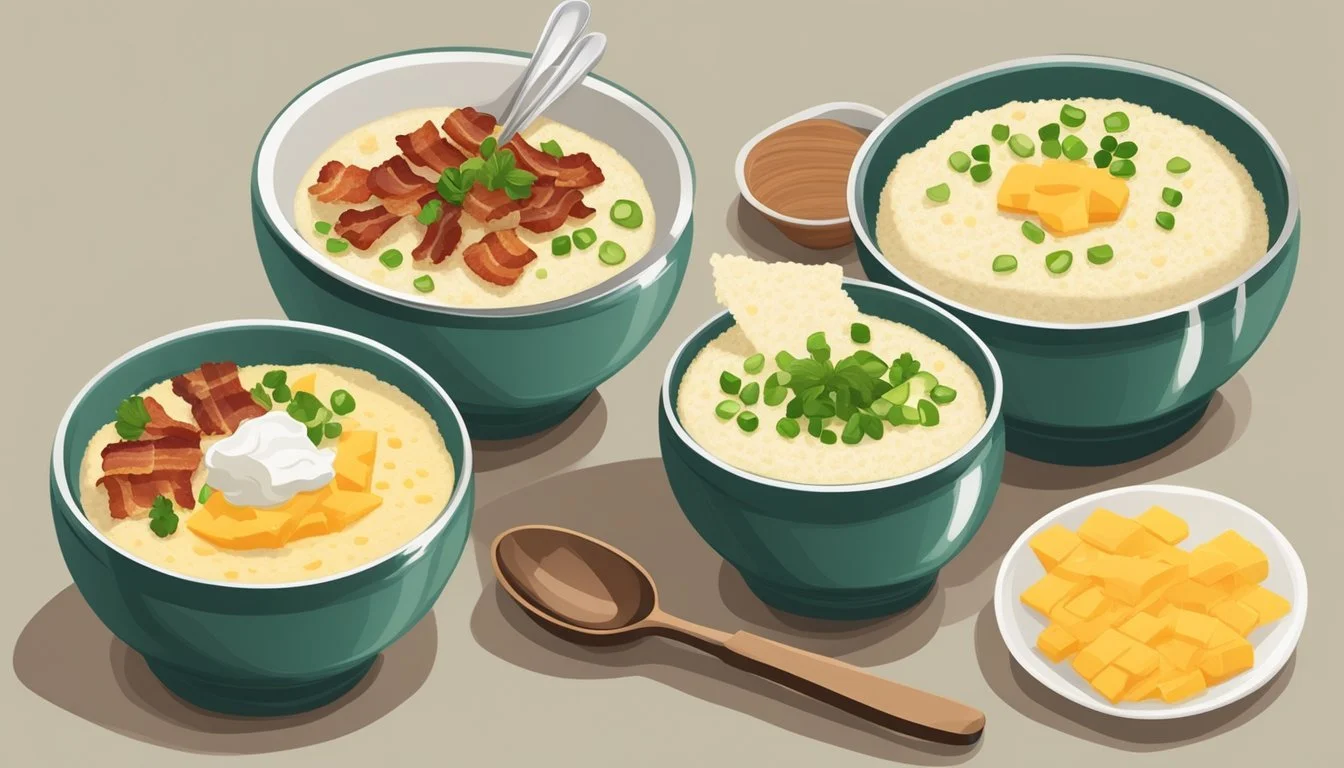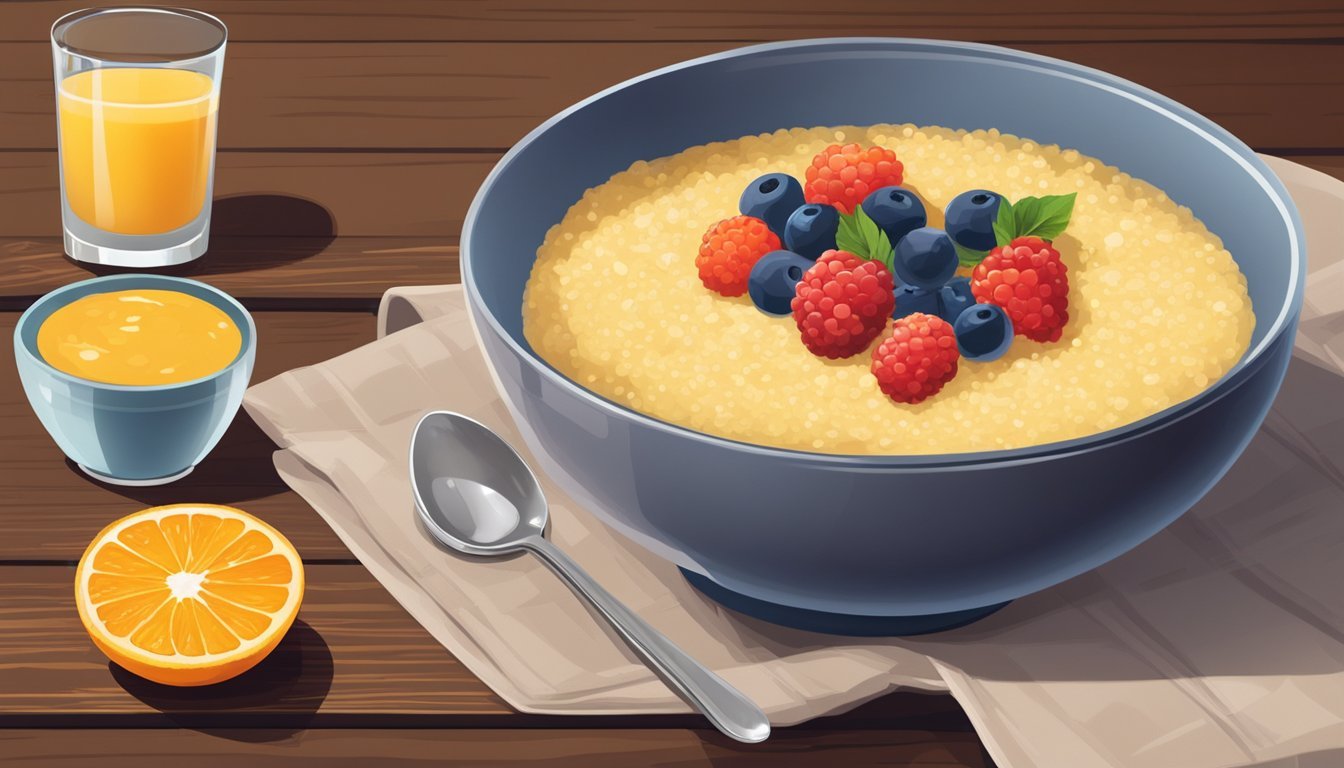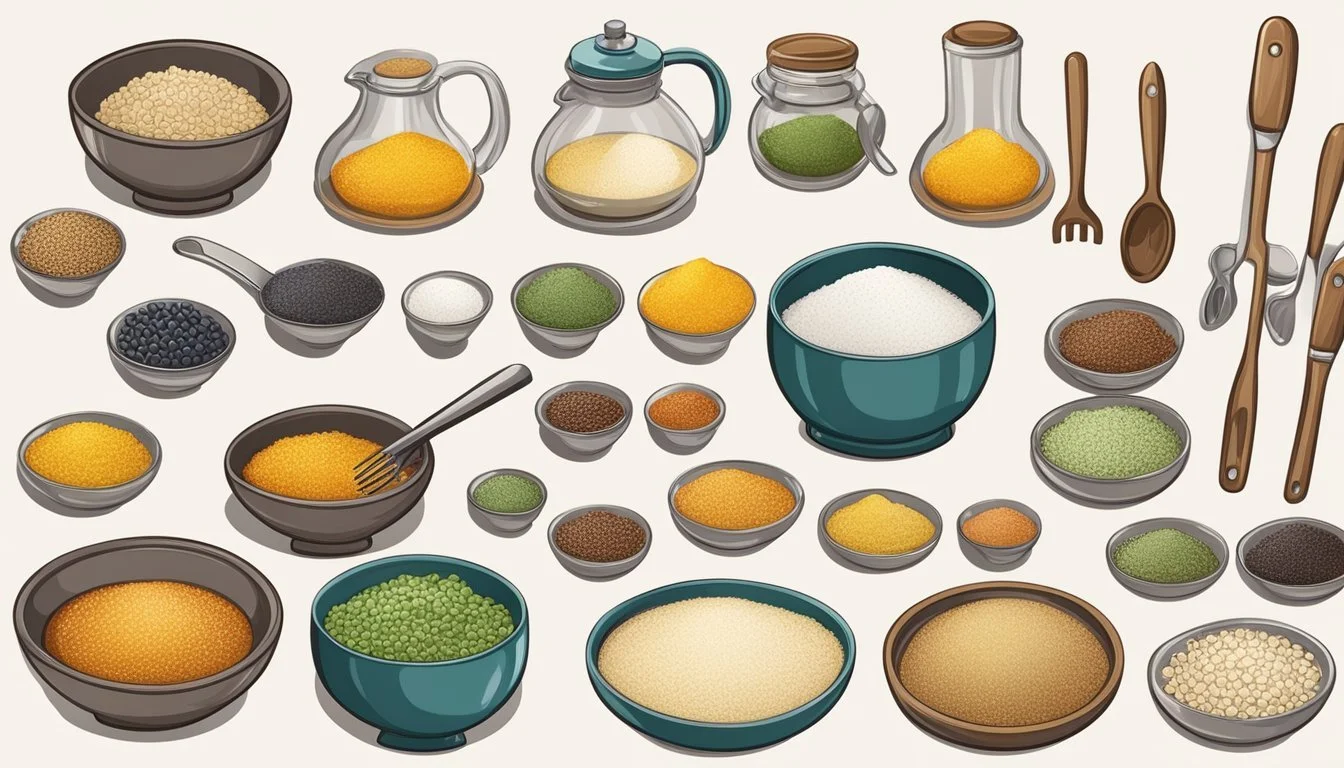Instant Grits Breakfast Bowls
Quick and Nutritious Morning Recipes
Instant grits breakfast bowls offer a quick and convenient way to enjoy a classic Southern dish with a modern twist. Grits, a dish made from ground corn, have been a staple in the Southern United States for generations. Traditionally, grits are slow-cooked to a creamy consistency, but instant grits make the dish accessible for those with busy lifestyles. These bowls incorporate a variety of flavorful toppings that can transform the humble grits into a hearty and satisfying meal, perfect for breakfast or any time of the day.
Incorporating instant grits into breakfast bowls caters to the increasing demand for speedy yet wholesome meal options. By simply adding boiling water or a quick stint in the microwave, the grits are ready in minutes, serving as a blank canvas for a myriad of toppings. Proteins such as bacon, eggs, or cheese and vegetables like sautéed peppers or green onions (What wine goes well with onions?) can be added to enhance the flavor profile of the dish. These bowls not only save time but also allow for customization according to individual taste preferences, dietary constraints, and nutritional needs.
The versatility of instant grits breakfast bowls is unmatched, providing a satisfying solution for both savory and sweet flavor cravings. It's a dish that can be adapted to suit the season, occasion, or the available ingredients in one's kitchen. Whether topped with a sprinkle of sharp cheddar cheese and a perfectly cooked egg or a pat of butter and a drizzle of honey, instant grits breakfast bowls remain an endearing and timeless choice for a nourishing start to the day.
History and Origin of Grits
Grits, a dish deeply rooted in history, originated from a Native American corn dish and evolved into a Southern culinary staple known for its versatility from breakfast to dinner.
From Corn to Grits
Grits are made from corn, specifically the hard varieties such as dent or flint, which are rich in starch. The corn is processed to remove the hard hull and then ground into smaller particles. The process typically involves stone-ground methods, which preserve the nutrient content and flavor of the corn. Historically, the transformation from corn to grits occurred in Native American communities long before European colonization.
Grits in Southern Cuisine
In the South, grits have been a fundamental part of the diet, cementing their place in the regional cuisine for centuries. Grits gained popularity in the southern United States due to their adaptability in dishes and the availability of corn. Known for their warm, creamy texture when cooked, they serve as a base for various toppings, ranging from simple butter to spicy shrimp. The dish's simplicity and comfort have helped it maintain its status as a Southern classic.
Nutritional Profile of Grits Breakfast Bowls
A grits breakfast bowl can be a nutritious start to one's day, offering a balance of carbohydrates, protein, and fats. Grits, made from ground corn, are a staple in Southern cuisine and possess a simple flavor profile that pairs well with a variety of ingredients.
Calories: A single serving of grits contains about 182 calories for a quarter-cup portion of cooked regular grits. When additional ingredients like eggs, cheese, and meats are added to a breakfast bowl, the calorie count naturally increases.
Nutrient Amount per serving Total Fat Small; varies with add-ins Saturated Fat Minimal; higher with cheese or butter Cholesterol Present in eggs and meat Sodium Moderate; higher with added seasonings Carbohydrates Approx. 38 grams Fiber About 2 grams Sugar Low; naturally occurring in corn Protein 4 grams; more with eggs, cheese, or meat
Grits, primarily a source of carbohydrates, offer sustained energy. The added fiber aids in digestion, though grit amounts are relatively modest. Protein content can be boosted significantly with the inclusion of eggs or meats such as sausage and bacon.
While typically low in sugar, preparation and accompaniments can increase this amount. The total fat content is subject to variation based on what is mixed into the bowl, like butter, cheese, or meat. If prepared with water and without high-fat ingredients, grits can be low in saturated fat and cholesterol.
When considering the nutritional profile of grits breakfast bowls, it's helpful to know that it can be tailored to fit various dietary needs by adjusting the add-ins. Simple swaps or omissions can transform the bowl into a heart-friendly option or one that satisfies those looking for a more indulgent breakfast experience.
Instant Grits: What Are They?
Instant grits are a convenient and quick variation of traditional grits that offer a fast-paced solution for a hearty breakfast. They are made from pre-cooked and dehydrated ground corn, enabling a shorter cooking time.
Types of Grits
Stone-Ground Grits: These are made from whole, dried corn kernels that are coarsely ground. They deliver a more textured and flavorful experience but require longer cooking times.
Instant Grits: Instant grits are finely ground and pre-cooked before drying. This process ensures that they can be prepared in a fraction of the time compared to stone-ground grits.
Comparing Instant Grits to Other Forms
Texture & Flavor:
Instant Grits: They often have a smoother texture and milder flavor due to the fine grinding and pre-cooking process.
Stone-Ground Grits: These usually offer a more robust corn flavor and a coarser, chewier texture, which is preferred by some.
Preparation Time:
Instant Grits: They can be ready in about 5 minutes or less, ideal for those seeking a quick meal.
Stone-Ground Grits: Cooking time can range from 20 minutes to an hour, better suited for leisurely meals or when more control over texture is desired.
As a staple of Southern cuisine, grits come in various forms besides instant and stone-ground, such as quick grits, but this comparison focuses on the aspects most relevant to instant grits.
Essential Ingredients for Grits Breakfast Bowls
The foundational element of a grits breakfast bowl is, unsurprisingly, grits. They can either be stone-ground or instant, with both requiring different cook times.
Grits:
Stone-ground grits are traditional and have a coarser texture.
Instant grits are pre-cooked and dried, allowing for a quick preparation.
Liquid for Cooking:
Water: The essential liquid for cooking grits, usually in a ratio of 4 parts water to 1 part grits.
Milk: Some recipes substitute part of the water with milk for creamy grits.
Cream: Heavy cream can be added for richness.
Seasonings:
Salt: Necessary to enhance the flavor of the grits.
Butter: Commonly added to cooked grits for a smooth and rich finish.
Cheese:
Cheddar Cheese: Adding cheese to grits creates 'cheese grits,' a beloved variant.
Shredded Cheddar Cheese: Often sprinkled on top for extra flavor and texture.
Proteins:
Eggs: A key ingredient, often soft-boiled, scrambled, or fried to preference.
Bacon: Provides a crunchy, salty contrast.
Sausage: Another popular meat addition that can be sliced or crumbled.
Accompaniments:
Green Onions: A common garnish that adds both color and a mild onion flavor.
Grits breakfast bowls are versatile and can be adapted to include multiple combinations of the above ingredients to cater to individual preferences. By incorporating these essentials, one can create a warm, comforting meal tailor-fit to their taste.
Cooking Instructions for Grits Breakfast Bowls
A grits breakfast bowl offers a hearty start to the day, combining the creaminess of grits with a range of customizable toppings for added flavor and texture.
Preparing the Grits
To prepare the base of the grits breakfast bowls, one should start by boiling a mixture of milk and water in a saucepan. Once boiling, gradually whisk in the grits to avoid lumps. Reduce the heat to a simmer and allow the grits to cook until they achieve a creamy texture. To enhance creaminess and flavor, stirring in a pat of butter and some shredded cheese will transform these into creamy cheese grits. For those who prefer a quicker option or lack access to a stove, instant grits can also be prepared in the microwave, following package instructions to ensure they come out just as delicious.
Ingredients for Stove Preparation:
1 cup of grits
2 cups of water
2 cups of milk
Salt to taste
Butter and shredded cheese (optional)
Microwave Alternative:
Use instant grits packet
Follow specified water or milk ratios on the package
Customizing with Toppings
Once the base is ready, the grits bowl can be tailored with a variety of toppings. Eggs cooked to preference—whether scrambled eggs with runny yolks or perfectly fried eggs—make a protein-rich addition. One can also sprinkle additional shredded cheese on top for more gooey goodness. For those who enjoy a bit of zest, a dash of hot sauce will give a spicy kick that complements the creamy grits. Using a skillet ensures that toppings like eggs are cooked just right and can be conveniently used alongside the saucepan for efficient meal preparation.
Suggested Toppings:
Eggs (fried, scrambled, or soft boiled)
Shredded cheese
Hot sauce
Fresh herbs
Sautéed vegetables
Bacon or sausage pieces
By following these simple steps, one can create a grits breakfast bowl that is not only easy to make but also incredibly satisfying and adaptable to individual tastes.
Recipe Variations and Ideas
Instant grits provide a quick and versatile base for an array of breakfast bowls. These dishes can be easily customized to suit different tastes and preferences, ensuring a satisfying start to the day.
Cheesy Grits Breakfast Bowls
Cheesy grits transform a simple dish into a creamy delight. To make cheese grits breakfast bowls, one needs to stir in a generous amount of shredded cheese, such as cheddar, into the cooked grits until it's perfectly melted. For added flavor, one can top the cheese grits with a sprinkle of green onions and a dollop of salsa for a zesty kick.
Ingredients Quantity Cooked Grits 1 bowl Shredded Cheddar to taste Green Onion 1 tbsp, sliced Salsa 2 tbsp
Grits with Eggs and Bacon
Grits paired with eggs and bacon make a classic combination for a hearty breakfast. One can cook large eggs to their preference—scrambled, fried, or poached. Crispy bacon adds a savory crunch that complements the smooth grits. To assemble, simply layer the eggs over the grits and crumble the bacon on top.
Ingredients Quantity Cooked Grits 1 bowl Large Eggs 1-2, cooked as desired Bacon 1-2 slices, cooked and crumbled
Shrimp and Grits Bowls
Shrimp and grits offer a luxurious take on the classic grits bowl, perfect for when one craves something extra special. Saute shrimp with onions and a pinch of garlic until they're just cooked, then lay them over a bed of cheesy, buttery grits. Enhance this dish with a sprinkle of herbs for a gourmet touch.
Ingredients Quantity Cooked Grits 1 bowl Shrimp 4-5, peeled Onions 2 tbsp, diced Garlic 1 tsp, minced Shredded Cheese to taste Fresh Herbs 1 tbsp, chopped
Serving and Presentation Tips
When assembling Instant Grits Breakfast Bowls, presentation enhances both visual appeal and taste. Attention to plating and garnishing can transform a simple meal into an attractive brunch centerpiece.
Plating Techniques
For plating, one should consider the size and depth of the bowl to ensure proper serving portions and aesthetic balance. Breakfast bowls typically hold one cup of grits, an ideal serving size. Layering is key: starting with cheese grits as the base, toppings are added in a manner that showcases variety and color. For a traditional Southern breakfast, placing the egg on top draws the eye, while a light sprinkling of bright ingredients like chopped chives or green onions around the edge gives a fresh contrast.
Garnishing with Herbs
Garnishing plays a crucial role not only in flavor but also in presentation. A small bunch of herbs can be placed on top of the bowls to add a vibrant touch. Chopped chives and green onions are not only aromatic but also offer a crisp texture and a burst of color. They should be sprinkled with a deliberate hand for an even distribution that doesn't overpower the other elements in the bowl.
Health Considerations When Eating Grits
When incorporating instant grits into a breakfast routine, it's important to consider their nutritional profile. Instant grits are a processed version of traditional stone-ground grits, typically enriched with nutrients but can also be higher in sodium.
Nutritional Content:
Calories: Instant grits contain calories that can contribute to daily energy needs.
Fiber: They provide a smaller amount of fiber, around 2 grams per cup, compared to alternatives like rolled oats.
Protein: A serving contains about 3 grams of protein.
Micronutrients:
Instant grits are often fortified with essential vitamins and minerals. For instance, a single serving may deliver 100% of the iron's daily value. They also contain B-vitamins, including folate, essential for various bodily functions.
Considerations:
Sodium: Prepackaged versions might contain added salt, elevating the sodium content, which in excess can be a concern for blood pressure.
Sugar: Flavorings or additives in some instant grit varieties may increase sugar content.
Saturated Fat and Cholesterol: Grits generally have negligible amounts of saturated fat and cholesterol, making them a heart-healthy choice when consumed without high-fat toppings.
Glycemic Index: As a corn-based product, grits have a higher glycemic index and may affect blood sugar levels.
For a nutritionally balanced meal, one can combine grits with sources of healthy fats, such as nuts or avocados, and a side of fruits or vegetables to enhance the fiber content. It's advisable to choose plain instant grits to control the addition of sugar, salt, and fats.
Alternative Grits Recipes for Restricted Diets
Finding the right breakfast bowl can be challenging for those with dietary restrictions, but there are plenty of grits recipes that cater to gluten-free, whole grain, low-calorie, and low-fat preferences. These variations ensure that everyone can enjoy a warm and satisfying meal to start their day.
Gluten-Free and Whole Grain Options
For those avoiding gluten, corn-based grits and polenta serve as excellent alternatives, as they are naturally gluten-free. Individuals can opt for stone-ground varieties, which tend to preserve more of the natural fiber and nutrients. When preparing these dishes, they should be mindful of any added ingredients to ensure the entire recipe remains gluten-free.
Cheese Grits: Substitute traditional cheese with a gluten-free cheese to maintain the rich flavor without adding gluten.
Polenta: A suitable alternative for those who prefer a coarser texture, polenta can be enriched with gluten-free, low-fat cheeses or herbs for additional flavor.
Low-Calorie and Low-Fat Variations
Calories and fats can quickly add up in traditional grits recipes, but with a few modifications, individuals can create healthier versions:
Oats: Replacing grits with oats can reduce the caloric and fat content while still providing a similar texture and satisfying breakfast option.
Low-Sodium and Low-Fat Cheese: To cut back on sodium and fat, recipes can incorporate low-sodium and low-fat cheese options, which dramatically reduce the overall fat content without compromising taste.
Note: Cooking methods matter as well. Steaming or boiling instead of frying can help maintain lower calorie and fat counts in these breakfast bowls.
Social Media Engagement and Grits Recipes
The proliferation of food content on social media has transformed the way cooks share and discover grits recipes. From seasoned chefs to kitchen novices, social media platforms offer a stage for everyone to broadcast their culinary experiments with this Southern staple.
Sharing Your Creations Online
One can simply snap a photo and post their latest grits breakfast bowl on platforms like Instagram or Facebook, garnishing their post with relevant hashtags such as #GritsBowl or #BreakfastGoals. This not only showcases their creation but also invites feedback and interaction from fellow food enthusiasts. Guides on crafting the perfect post include:
Composing the shot: Placing the grits breakfast bowl in natural lighting with a clean background.
Capturing the details: A close-up showing the creamy texture of the grits or the vibrant colors of accompanying toppings.
Users should remember to tag their photos with specific keywords like #InstantGrits and #QuickBreakfast to draw viewers specifically interested in these types of recipes.
Engaging with the Grits Community
Platforms such as Pinterest serve as a treasure trove for discovering an array of grits recipes. Users can curate their own collection of favorites and leverage the platform's algorithm to find and follow other grit aficionados. When someone shares a particularly innovative or traditional recipe, engaging with the content through comments or shares can lead to a vibrant exchange of ideas. The following actions encourage community engagement:
Commenting: Offering tips or asking for advice on recipe variations.
Sharing: Reposting favorite recipes to one's own feed with a personal anecdote or suggestion.
Users can contribute to the grits community discourse by sharing stories of their culinary successes or mishaps, fostering a sense of camaraderie and collective learning.









